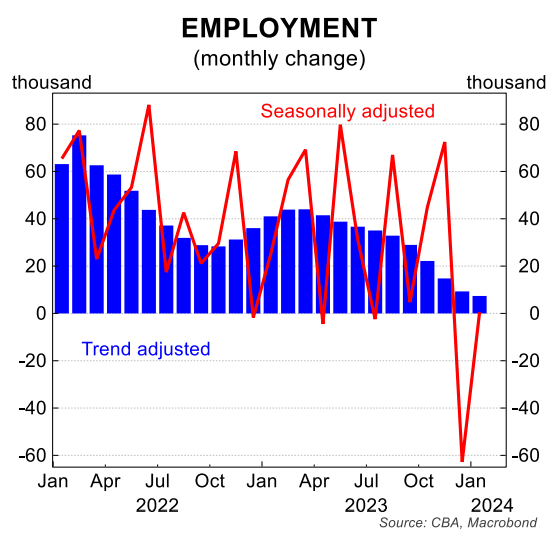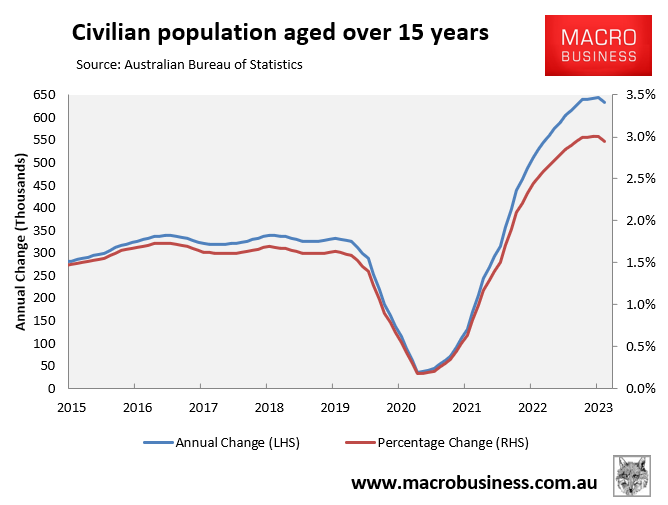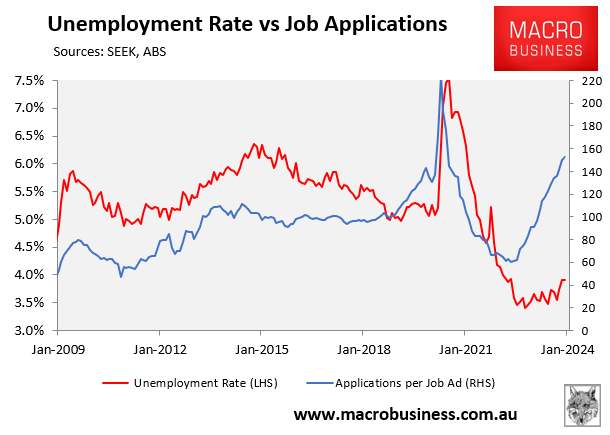Thursday’s labour force release for January from the Australian Bureau of Statistics (ABS) has cast doubt on the Reserve Bank of Australia’s (RBA) latest forecast that the nation’s unemployment rate would end 2024 at 4.3%.

To recap, Australia’s unemployment rate rose to 4.1% in January with only 5000 jobs created over the month.

The bigger worry was that the number of hours worked across the economy has plummeted over the past six months, to be up only 0.7% year-on-year.

The sluggish 0.7% growth in annual hours worked is against a 2.9% increase in the civilian working age population over the year to January:

CBA has estimated previously that Australia needs to create nearly 35,000 jobs a month to keep the unemployment rate stable (assuming a steady participation rate) just to soak up the additional workers piling into the economy (mostly via record net overseas migration).

Delivering strong job growth when the economy is experiencing a per capita recession amid high interest rates is an impossible task, meaning the unemployment rate will necessarily rise.
As shown in the next chart from Alex Joiner at IFM Investors, January’s 4.1% unemployment rate is already tracking ahead of the RBA’s forecast:

As noted by Joiner, “the pace at which the labour market loosens, beyond what the Bank expects, is just as important for the rate cut outlook as the pace of disinflation. Higher the unemployment the sooner the cuts”.
Gareth Aird, head of Australian economics at CBA, made similar observations on Thursday, tipping rate cuts beginning in September:
“The softness in the recent run of monthly labour force data is better marrying up with the weak growth picture. That story has further to run”…
“The loosening in the labour market will weigh on wages growth in 2024 and by extension inflation. We receive an update on Q4 23 wages next week with the Wage Price Index. We expect a lift of 0.9%/qtr and for the annual pace of wages growth to hold at 4.0%”.
“Looking ahead, we remain comfortable with our call that the unemployment rate will rise more quickly than the RBA anticipates in 2024″…
“We believe RBA rate cuts will be required this year to prevent the unemployment rate from rising much above 4.5%”.
“Today’s data is consistent with our base case that sees the RBA commence an easing cycle in September (we have 75bp of cuts in our profile by end 2024 and a further 75bps in H1 25)”.
We wholeheartedly agree and have made similar arguments repeatedly.
The writing has been on the wall for months with Seek’s labour force surveys showing a sharp rise in the number of applicants per job ad, reflecting weakening demand and strong labour supply:

It was only a matter of time before the ABS labour force data began catching up with the weakness across the economy.
And when it does, the RBA will be forced to cut rates to stem the bleeding.

